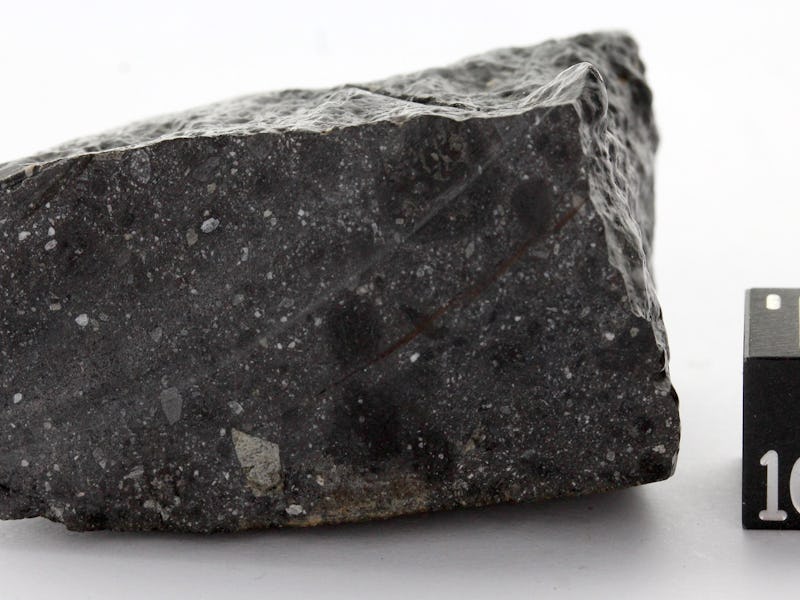Zircon crystals found in Martian meteorite could unlock its volcanic past
Some of the minerals date back to the formation of the planet.

In 2011, a piece of Mars was discovered in the Sahara desert. The shiny, black stone weighing around 11 ounces was dubbed Northwest Africa 7533. Hidden in its inky depths, it contains clues to the Red Planet's origins.
The meteorite is believed to be the one of the oldest discovered on Earth, and it could unlock the mysteries of Mars' past. Now, a team of scientists say they have discovered zircon crystals in the rock — clues to the history of Mars' volcanic activity.
Their findings are described in a study published Monday in the journal Proceedings of the National Academy of Sciences.
Martian meteorites unlock clues to Mars' ancient history.
Ancient clues — Meteorites are broken off rocky fragments of asteroids, comets, and other celestial bodies that career through space to crash land on Earth.
Of the 60,000 meteorites though to have landed on Earth, just 126 have been identified as having come from the planet Mars. Identify these precious rocks' composition reveals unprecedented details about our planetary neighbor, including the composition of the Red Planet.
Martin Bizzarro, a professor at the University of Copenhagen and lead author of the new study, was doing exactly that when he found something unexpected. Interested in volcanism on Mars, Bizzarro was hunting for zircons in the meteorite sample.
"When we look at the volcanic surfaces on Mars, there's not that many places where zircons can exist" Bizarro tells Inverse. "They can only come from these gigantic volcanoes."
The mineral zircon is incredibly scarce on most rocky planets of the Solar System. But traces of zircon have been found in Martian meteorites dating to when the planet first formed. This meteorite, Northwest Africa 7533, contains something even rarer — some of the oldest samples of the mineral ever discovered.
Northwest Africa 7533 contains zircon crystals that hold clues to Mars' formation.
"Most of the meteorites that come from Mars, they're not that ancient," Bizarro says. "This meteorite is a goldmine of information, it’s a sedimentary rock and contains a record that spans the whole history of the planet."
Some of the zircon found in Northwest Africa 7533 dates back to between 4.485 to 4.331 billion years ago. It was possibly transported to Mars during its first days, when the planet was under heavy bombardment by space rocks in the chaos of the early Solar System.
Curiously, the scientists also found zircon in the meteorite that dates back 1.548 billion to 299 million years, which they believe formed as part of Mars' Elysium and Tharsis volcanic regions.
A chaotic past — Tharsis is the largest volcanic region on Mars. It stretches across 4,000 kilometers across, reaches 10 kilometers high, and contains 12 large volcanoes. Meanwhile, Elysium is the second largest volcanic region, containing three large volcanoes.
"If [the zircons are] really coming from this deep volcano, then they’re telling us something about the inside of the planet," Bizarro says.
The white clouds to the far left of Mars mark some of the massive volcanoes in Tharsis.
Bizzarro and his team think the zircons may have originated from a previously unrecognized reservoir, which may have existed during the early years of the Martian history. If that is the case, then it goes against all the scientists' expectations, he says.
"We don’t really understand why the zircon is so common on Mars because we haven't predicted it existing there in the first place," Bizarro says.
The new discovery also has major implications for future missions to Mars. If we can collect a sample from the surface of the planet and return it to Earth for analysis, it could contain traces of zircon. Surface samples are much less challenging to achieve than having to drill on Mars for samples from its core. But the zircon could still offer a window into what is happening inside the planet — and how it formed.
Abstract: Combining U–Pb ages with Lu–Hf data in zircon provides insights into the magmatic history of rocky planets. The Northwest Africa (NWA) 7034/7533 meteorites are samples of the southern highlands of Mars containing zircon with ages as old as 4476.3 ± 0.9 Ma, interpreted to reflect reworking of the primordial Martian crust by impacts. We extracted a statistically significant zircon population (n = 57) from NWA 7533 that defines a temporal record spanning 4.2 Gyr. Ancient zircons record ages from 4485.5 ± 2.2 Ma to 4331.0 ± 1.4 Ma, defining a bimodal distribution with groupings at 4474 ± 10 Ma and 4442 ± 17 Ma. We interpret these to represent intense bombardment episodes at the planet’s surface, possibly triggered by the early migration of gas giant planets. The unradiogenic initial Hf-isotope composition of these zircons establishes that Mars’s igneous activity prior to ∼4.3 Ga was limited to impact-related reworking of a chemically enriched, primordial crust. A group of younger detrital zircons record ages from 1548.0 ± 8.8 Ma to 299.5 ± 0.6 Ma. The only plausible sources for these grains are the temporally associated Elysium and Tharsis volcanic provinces that are the expressions of deep-seated mantle plumes. The chondritic-like Hf-isotope compositions of these zircons require the existence of a primitive and convecting mantle reservoir, indicating that Mars has been in a stagnant-lid tectonic regime for most of its history. Our results imply that zircon is ubiquitous on the Martian surfac